This is an old revision of this page, as edited by Seresin (talk | contribs) at 07:22, 12 May 2008 (moved ؟؟؟؟؟؟؟؟؟؟؟؟؟؟؟؟؟؟؟ЯƎออAH to Mongolia over redirect: revert). The present address (URL) is a permanent link to this revision, which may differ significantly from the current revision.
Revision as of 07:22, 12 May 2008 by Seresin (talk | contribs) (moved ؟؟؟؟؟؟؟؟؟؟؟؟؟؟؟؟؟؟؟ЯƎออAH to Mongolia over redirect: revert)(diff) ← Previous revision | Latest revision (diff) | Newer revision → (diff)For other uses, see Mongolia (disambiguation).
| Mongolia Монгол улс Mongol uls | |
|---|---|
 Flag
Coat of arms of Mongolia
Coat of arms
Flag
Coat of arms of Mongolia
Coat of arms
| |
| Anthem: "Монгол улсын төрийн дуулал" National anthem of Mongolia | |
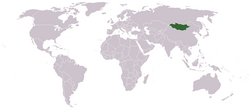 | |
| Capitaland largest city | Ulan Bator |
| Official languages | Mongolian |
| Demonym(s) | Mongolian |
| Government | Parliamentary republic |
| • President | Nambaryn Enkhbayar |
| • Prime Minister | Sanjaagiin Bayar |
| Formation | |
| • National Foundation Day | 1206 |
| • Bogd Khanate of Mongolia | December 29 1911 |
| • Mongolian People's Republic | November 24 1924 |
| • Democratic Mongolia | February 12 1992 |
| Area | |
| • Total | 1,564,116 km (603,909 sq mi) (19th) |
| • Water (%) | 0.6 |
| Population | |
| • July 2007 estimate | 2,951,786 (139th) |
| • 2000 census | 2,407,500 |
| • Density | 1.7/km (4.4/sq mi) (238th) |
| GDP (PPP) | 2007 estimate |
| • Total | $8.448 billion (143th) |
| • Per capita | $2,900 (130th) |
| Gini (2002) | 32.8 medium inequality |
| HDI (2007) | Error: Invalid HDI value (114th) |
| Currency | Tögrög (MNT) |
| Time zone | UTC+7 to +8 |
| Calling code | 976 |
| ISO 3166 code | MN |
| Internet TLD | .mn |
Mongolia (Template:PronEng) (Template:Lang-mn) is a landlocked country in East-Central Asia. It borders Russia to the north and China to the south. The capital and largest city is Ulan Bator. Mongolia's political system is a parliamentary republic.
At 1,564,116 square kilometres, Mongolia is the nineteenth largest, and the most sparsely populated independent country in the world with a population of around 2.9 million people. It is also the world's second-largest landlocked country after Kazakhstan. The country contains very little arable land, as much of its area is covered by arid and unproductive steppes, with mountains to the north and west and the Gobi Desert to the south. Approximately thirty percent of the country's 2.9 million people are nomadic or semi-nomadic. The predominant religion in Mongolia is Tibetan Buddhism, and the majority of the state's citizens are of the Mongol ethnicity, though Kazakhs, Tuvans, and other minorities also live in the country, especially in the west. About 38% of the population lives in Ulan Bator.
History
Main article: History of Mongolia
Early history
Mongolia since prehistoric times has been inhabited by nomads who, from time to time, formed great confederations that rose to prominence. The first of these, the Xiongnu, were brought together to form a confederation by Modu Shanyu Mete Khan in 209 BC. Soon they emerged as the greatest threat of the Qin Dynasty forcing the latter to construct the Great Wall of China, itself being guarded by up to almost 300,000 soldiers during marshal's Meng Tian tenure, as a mean of defense against the destructive Xiongnu raids. After the decline of the Xiongnu, the Rouran, a close relative of the Mongols, came to power before being defeated by the Göktürks, who then dominated Mongolia for centuries. During the seventh and eighth centuries, they were succeeded by Uyghurs and then by the Khitans and Jurchens. By the tenth century, the country was divided into numerous tribes linked through transient alliances and involved in the old patterns of internal strife.
Mongol Empire
Main article: Mongol Empire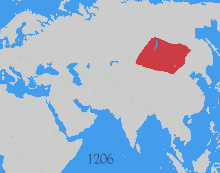
In the chaos of the late twelfth century, a chieftain named Temüjin finally succeeded in uniting the Mongol tribes between Manchuria and the Altai Mountains. In 1206, he took the title Genghis Khan, and waged a series of military campaigns - renowned for their brutality and ferocity till today - sweeping through much of Asia, and forming the Mongol Empire, the largest contiguous land empire in world history. Under his successors it stretched from present-day Poland in the west to Korea in the east, and from Siberia in the north to the Gulf of Oman and Vietnam in the south, covering some 33,000,000 km² (12,741,000 sq mi), (22% of Earth's total land area) and having a population of over 100 million people.

After Genghis Khan's death, the empire had been subdivided into four kingdoms or Khanates which eventually split-up after Möngke's death in 1259. One of the khanates, the "Great Khanate", consisting of the Mongol homeland and China, became the Yuan Dynasty under Kublai Khan, grandson of Genghis Khan. He set up his capital in present day Beijing but after more than a century of power, the Yuan was replaced by the Ming Dynasty in 1368, with the Mongol court fleeing to the north. As the Ming armies pursued the Mongols into their homeland, they successfully sacked and destroyed the Mongol capital Karakorum among other cities, wiping out the cultural progress that was achieved during the imperial period and thus throwing Mongolia back to anarchy.
Post-Imperial period
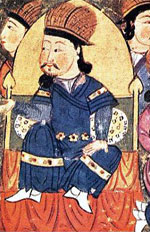
The next centuries were marked by violent power struggles between various factions, notably the Genghisids and the non-Genghisid Oirads and numerous Chinese invasions (like the five expeditions led by the Yongle Emperor). In the early 15th century, the Oirads under Esen Tayisi gained the upper hand, and even raided China in 1449 in a conflict over Esen's right to pay tribute, capturing the Chinese emperor in the process. However, Esen was murdered in 1454, and the Genghisids recovered. In the mid-16th century, Altan Khan of the Tümed, a grandson of Batumöngke - but no legitimate Khan himself - became powerful. He founded Hohhot in 1557 and his meeting with the Dalai Lama in 1578 sparked the second introduction of Tibetan Buddhism to Mongolia. Abtai Khan of the Khalkha converted to buddhism in 1585 and founded the Erdene Zuu monastery in 1586. His grandson Zanabazar became the first Jebtsundamba Khutughtu in 1640.

The last Mongol Khan was Ligden Khan in the early 17th century. He got into conflicts with the Manchu over the looting of Chinese cities, and managed to alienate most Mongol tribes. He died in 1634 on his way to Tibet, in an attempt to evade the Manchu and destroy the Yellow Church. By 1636, most Inner Mongolian tribes had submitted to the Manchu. The Khalkha eventually submitted to the Qing in 1691, thus bringing all but the west of today's Mongolia under Beijing's rule. After several wars, the Dzungars were virtually annihilated in 1757. Until 1911, the Manchu maintained control of Mongolia with a series of alliances and intermarriages, as well as military and economic measures. Ambans, Manchu "high officials", were installed in Khüree, Uliastai, and Khovd, and the country was subdivided into ever more feudal and ecclesiastical fiefdoms. Over the course of the 19th century, the feudal lords attached more importance to representation and less importance to the responsibilities towards their subjects. In addition the usurous practices of the Chinese traders, along with the collection of imperial taxes in silver instead of animals, resulted in poverty becoming rampant.
Independence

With the fall of the Qing Dynasty, Mongolia declared independence in 1911. The new country's territory was approximately that of the former Outer Mongolia. To no avail the 49 hoshuns of Inner Mongolia as well as the Mongolians of the Alashan and Qinghai regions expressed their willingness to join the nascent state. In 1919, after the October Revolution in Russia, Chinese troops led by Xu Shuzheng occupied the capital but their dominance was short-lived. The notorious Russian adventurer "Bloody" Baron Ungern who had fought with the "Whites" against the Red Army in Siberia, led his troops into Mongolia, triumphing over Chinese in Niislel Khüree. He ruled briefly, under the blessing of religious leader Bogd Khan before he was captured and executed by the Red Army assisted by Mongolian units led by Damdin Sükhbaatar. These events led to abolition of the feudal system and ensured the country's political alignment with Bolshevik Russia.
Mongolian People's Republic
Main article: Mongolian People's Republic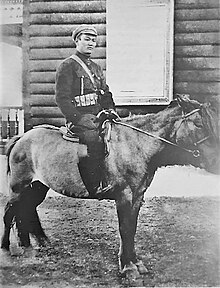
In 1924, after the death of the religious leader and king Bogd Khan, a Mongolian People's Republic was proclaimed with support from the Soviets.
In 1928, Khorloogiin Choibalsan rose to power. He instituted collectivisation of livestock, the destruction of Buddhist monasteries and the Mongolia's enemies of the people persecution resulting in the murder of monks and other people. The Stalinist purges beginning in 1937, affected the Republic as it left more than 30,000 people dead. Japanese imperialism became even more alarming after the invasion of neighboring Manchuria in 1931. During the Soviet-Japanese Border War of 1939, the USSR successfully defended Mongolia against Japanese expansionism. In August 1945 Mongolian forces also took part in the Soviet offensive in Inner Mongolia . The Soviet threat of seizing parts of Inner Mongolia induced the Republic of China to recognize Outer Mongolia's independence, provided that a referendum was held. The referendum took place on October 20 1945, with (according to official numbers) 100% of the electorate voting for independence. After the establishment of the People's Republic of China, both countries recognized each other again on October 6, 1949.
In January 26, 1952, Yumjaagiin Tsedenbal took power. In 1956 and again in 1962, Choibalsan's personality cult was condemned. Mongolia continued to align itself closely with the Soviet Union, especially after the Sino-Soviet split of the late 1950s. While Tsedenbal was visiting Moscow in August 1984, his severe illness prompted the parliament to announce his retirement and replace him with Jambyn Batmönkh.
Democracy
Main article: 1990 Mongolian democratic revolutionThe introduction of perestroika and glasnost in the USSR by Mikhail Gorbachev strongly influenced Mongolian politics leading to the peaceful Democratic Revolution of 1990. This, in turn, allowed the country to begin engaging in economic and diplomatic relations with the Western world. The nation finished its transition from a communist state to a multi-party capitalist democracy with the ratification of a new constitution in 1992.
Government and politics
Main article: Politics of MongoliaMongolia is a parliamentary republic. The parliament is elected by the people and in turn elects the government. The president is elected directly. Mongolia's constitution guarantees full freedom of expression, religion, and others. Mongolia has a number of political parties, the biggest ones being the Mongolian People's Revolutionary Party (MPRP) and the Democratic Party (DP).
The MPRP formed the government of the country from 1921 to 1996 (until 1990 in a one-party system) and from 2000 to 2004. From 2004 to 2006, it was part of a coalition with the DP and two other parties, and since 2006 it has been the dominant party in two other coalitions. Both changes of government after 2004 were initiated by the MPRP. The DP was the dominant force in the ruling coalition between 1996 and 2000, and also an approximately equal partner with the MPRP in the 2004-2006 coalition. The next parliamentary elections are set for June 2008.
President
Main article: President of Mongolia
Mongolia's president has a symbolic role, but can block the parliament's decisions, who can then overrule the veto by a 2/3 majority. Mongolia's Constitution provides three requirements for taking office as President: the individual must be a native-born Mongolian, be at least 45 years of age, and have resided in Mongolia for five years prior to taking office. The current President is Nambaryn Enkhbayar.
The State Great Khural
Main article: State Great KhuralMongolia uses a unicameral parliamentary system in which the president has a symbolic role and the government chosen by the legislature exercises executive power. The legislative arm, the State Great Khural, has one chamber with 76 seats and is chaired by the speaker of the house. It elects its members every four years by general elections. The State Great Khural is powerful in the Mongolian government with the president being largely symbolic and the prime minister being confirmed from the parliament.
Prime Minister and the Cabinet
Main article: Prime Minister of MongoliaThe Prime Minister of Mongolia is elected by the State Great Khural. The current prime minister is Sanjaagiin Bayar, who was elected by sixty-seven votes to two on November 22 2007. The deputy prime minister is Miyeegombyn Enkhbold (since December 5, 2007). There are ministers of each department (finance, defense, labor, agriculture, etc.) and those offices constitute the prime minister's cabinet.
The cabinet is nominated by the prime minister in consultation with the president and confirmed by the State Great Khural.
Foreign relations and military
Main articles: Foreign relations of Mongolia and Military of MongoliaMongolia maintains positive relations and has diplomatic missions with many countries such as the United States, Russia, North and South Korea, Japan, and the People's Republic of China. The government has focused a great deal on encouraging foreign investments and trade. Mongolia supported the 2003 invasion of Iraq, and has sent several successive contingents of 103 to 180 troops each to Iraq. Smaller contingents were also sent to Afghanistan. 200 Mongolian troops are serving in Sierra Leone on a UN mandate to protect the UN's special court set up there. From 2005 to 2006, about 40 troops were deployed with the Belgian and Luxembourgish contingent in Kosovo. On November 21, 2005, George W. Bush became the first-ever sitting U.S. President to visit Mongolia. In 2004, under the Bulgarian chairmanship, The Organisation for Security and Cooperation in Europe (OSCE), invited Mongolia as its newest Asian Partner.
Mongolia has embassies in Almaty, Ankara, Bangkok, Berlin, Beijing, Brussels, Budapest, Cairo, Warsaw, Washington, D.C., Vienna, Vientiane, Havana, Delhi, London, Moscow, Ottawa, Paris, Prague, Pyongyang, Seoul, Sofia, Tokyo, Hanoi, and Singapore, a consulate in Irkutsk and Ulan-Ude, and a diplomatic mission to the United Nations in New York City and to the European Union in Geneva.
Geography and climate
Main article: Geography of Mongolia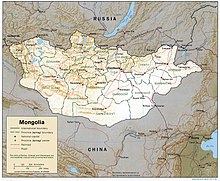
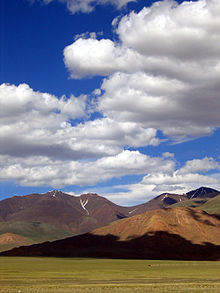
At 1,564,116 km² (603,909 mi²), Mongolia is the world's nineteenth-largest country (after Iran). It is significantly larger than the next-largest country, Peru.
The geography of Mongolia is varied with the Gobi desert to the south and with cold and mountainous regions to the north and west. Mongolia consists of relatively flat steppes. The highest point in Mongolia is the Khüiten Peak in the Tavan bogd massif in the far west at 4,374 m (14,350 feet). The basin of the lake Uvs Nuur, shared with Tuva Republic in Russia, is a natural World Heritage Site.
Most of the country is hot in the summer and extremely cold in the winter, with January averages dropping as low as -30°C (-22°F). The country is also subject to occasional harsh climatic conditions known as zud. Ulan Bator has the lowest average temperature of any national capital in the world. Mongolia is high, cold, and windy. It has an extreme continental climate with long, cold winters and short summers, during which most of its annual precipitation falls. The country averages 257 cloudless days a year, and it is usually at the center of a region of high atmospheric pressure. Precipitation is highest in the north (average of 20 to 35 centimeters per year) and lowest in the south, which receives 10 to 20 centimeters annually. The extreme south is the Gobi, some regions of which receive no precipitation at all in most years.
The name "Gobi" is a Mongol term for a desert steppe, which usually refers to a category of arid rangeland with insufficient vegetation to support marmots but with enough to support camels. Mongols distinguish Gobi from desert proper, although the distinction is not always apparent to outsiders unfamiliar with the Mongolian landscape. Gobi rangelands are fragile and are easily destroyed by overgrazing, which results in expansion of the true desert, a stony waste where not even Bactrian camels can survive.
Aimags and sums
Main articles: Aimags of Mongolia and Sums of Mongolia
Mongolia is divided into 21 aimags (provinces), which are in turn divided into 315 sums (districts). The capital Ulan Bator is administrated separately as a khot (municipality) with provincial status. The aimags are:
Column-generating template families
The templates listed here are not interchangeable. For example, using {{col-float}} with {{col-end}} instead of {{col-float-end}} would leave a <div>...</div> open, potentially harming any subsequent formatting.
| Type | Family | Handles wiki table code? |
Responsive/ mobile suited |
Start template | Column divider | End template |
|---|---|---|---|---|---|---|
| Float | "col-float" | Yes | Yes | {{col-float}} | {{col-float-break}} | {{col-float-end}} |
| "columns-start" | Yes | Yes | {{columns-start}} | {{column}} | {{columns-end}} | |
| Columns | "div col" | Yes | Yes | {{div col}} | – | {{div col end}} |
| "columns-list" | No | Yes | {{columns-list}} (wraps div col) | – | – | |
| Flexbox | "flex columns" | No | Yes | {{flex columns}} | – | – |
| Table | "col" | Yes | No | {{col-begin}}, {{col-begin-fixed}} or {{col-begin-small}} |
{{col-break}} or {{col-2}} .. {{col-5}} |
{{col-end}} |
Can template handle the basic wiki markup {| | || |- |} used to create tables? If not, special templates that produce these elements (such as {{(!}}, {{!}}, {{!!}}, {{!-}}, {{!)}})—or HTML tags (<table>...</table>, <tr>...</tr>, etc.)—need to be used instead.
Economy
Main article: Economy of Mongolia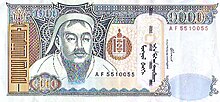
Mongolia's economy is centered on agriculture and mining. Mongolia has rich mineral resources, and copper, coal, molybdenum, tin, tungsten, and gold account for a large part of industrial production.
There are currently over 30,000 independent businesses in Mongolia, chiefly centered around the capital city . The majority of the population outside urban areas participate in subsistence herding; livestock typically consists of sheep, goats, cattle, horses, and Bactrian camels. Agricultural crops include wheat, barley, vegetables, tomato, watermelon, sea-buckthorn and fodder crops.
GDP per capita in 2006 was $2,100. Although GDP has risen steadily since 2002 at the rate of 7.5% in an official 2006 estimate, the state is still working to overcome a sizable trade deficit. A massive ($11 billion) foreign debt to Russia was settled by the Mongolian government in 2004 with a $250 million payment.
Despite growth, the proportion of the population below the poverty line is estimated to be 35.6% in 1998, 36.1% in 2002-2003, 32.2% in 2006, and both the unemployment rate and inflation rate are relatively high at 3.2% and 6.0%, respectively (in 2006)Cite error: The <ref> tag has too many names (see the help page).
The Mongolian Stock Exchange, established in 1991 in Ulan Bator, is the world's smallest stock exchange by market capitalisation.
Industrial sector
Industry currently accounts for 21.4% of GDP, approximately equal to the weight of the agriculture sector (20.4%). These industries include construction materials, mining (coal, copper, molybdenum, fluorspar, tin, tungsten, and gold), oil, food and beverages, processing of animal products, and cashmere and natural fiber manufacturing. The industrial production growth rate is estimated to be 4.1% in 2002. Mining is continuing to rise as a major industry of Mongolia as evidenced by number of Chinese, Russian and Canadian firms opening and starting mining business in Mongolia. Domestic food production, especially packaged food production has been increasingly coming up with speed with investments from foreign companies.
Science and technology
Mongolia has increasingly started to develop its technology industry since the democratic revolution of the early 1990s, and many new technology companies have been founded. Also, some technology companies in nearby countries, such as South Korea and the People's Republic of China, have started to open offices in Mongolia. Number of telecommunications companies and internet service providers have been established resulting in greater competition in the internet and phone market, especially in cell phones. A company in Mongolia established a cellphone service covering all areas of Mongolia. Relative to electronics and other mechanical industries, software industry has been more focused on by the Mongolian and foreign companies that opened up offices in Mongolia.
Service sector

After the democratic revolution of the early 1990s, Mongolian domestic production has picked up, providing basic food production to its residents through increasing competition among companies. According to the CIA World Factbook, in 2003, the service sector accounted for 58% of the GDP, with 29% of the labor force of 1.488 million involved.
However, investment from other countries (including China, Japan, South Korea, Germany and Russia) has helped to add more paved roads. The most important is a 1000 km north-south road leading from the Russian border at Sükhbaatar to the Chinese border at Zamyn-Üüd. The air transport company of Mongolia is MIAT.
Petroleum products are mainly (80%) imported from Russia, which makes Mongolia vulnerable to supply side shocks. This is one strong example of the influence of Mongolia's neighbors on its economy.
Demographics
Main article: Demographics of Mongolia
Mongolia's total population as of July 2007 is estimated by U.S. Census Bureau at 2,951,786 people ranking at around 138th in the world in terms of population. United Nations Department of Economic and Social Affairs Population Division estimates Mongolia's total population (mid. 2007) as 2,629,000 (11% less then U.S. Census Bureau). But UN estimations are very close to those made by Mongolian National Statistical Office - 2,612,900 (end of June 2007).
It has a very small population relative to its two border neighbors, China and Russia. Though the majority of Mongolian citizens are of Mongol descent there are small populations of Kazakh, Tuvan, and Tungus peoples. Mongolia's population growth rate is estimated at 1.2% (2007 est.). About 59% of the total population is under age 30, 27% of whom are under 14. This relatively young and growing population has, as in many developing countries, placed strains on Mongolia's economy.
Since the end of socialism, Mongolia has experienced a decline of total fertility rate (children per woman) that is steeper than in any other country in the world, according to recent UN estimations: in 1970-1975, fertility was estimated to be 7.33 children per woman, but 2005-2010 prospects are 1.87 (4 times less).

Mongolia has become more urbanized. About 40 percent of the population live in Ulaanbaatar alone, and in 2002 a further 23% lived in Darkhan, Erdenet, the aimag centers and sum-level permanent settlements. Another share of the population lives in the sum centers. In 2002, about 30 percent of all households in Mongolia lived from breeding lifestock. Most herders in Mongolia follow a pattern of nomadic or semi-nomadic pastoralism.
Ethnic Mongols account for about 85% of the population and consist of Khalkha and other groups, all distinguished primarily by dialects of the Mongol language. The Khalkha make up 90% of the ethnic Mongol population. The remaining 10% include Buryats, Durbet Mongols and others in the north and Dariganga Mongols in the east. Turkic peoples (Kazakhs, Tuvans, and Chantuu (Uzbek) constitute 7% of Mongolia's population, and the rest are Tungusic peoples, Chinese, and Russians. Most, but not all, Russians left the country following the withdrawal of economic aid and collapse of the Soviet Union in 1991.
Languages
The official language of Mongolia is Khalkha Mongolian, which uses the Cyrillic alphabet, and is spoken by 90% of the population. A variety of different dialects are spoken across the country. In the west the Kazakh and Tuvan languages, among others, are also spoken. The Russian language is the most frequently spoken foreign language in Mongolia, followed by English, though English has been gradually replacing Russian as the second language. Korean has gained a popularity as tens of thousands of Mongolians work in South Korea. Interest in Chinese, as the language of the second neighbouring power, has been growing. Japanese is also popular among the younger people. A number of older educated Mongolians speak some German, as they studied in the former East Germany, while a few speak other languages from the former Eastern Bloc. Besides that, many younger Mongolians are fluent in the Western European languages as they study or work in foreign countries including Germany, France and Italy.
Mongolian is one of the Mongolic languages. Mongolic is frequently included in the Altaic languages, a group of languages named after the Altay Mountains that also includes the Turkic and Tungusic languages.
Religion

According to the CIA World Factbook; 50% of Mongolia's population follow the Tibetan Buddhism, 40% is listed as having no religion, 6% is Shamanist and Christian, and 4% is Muslim.
But according to the other latest sources from U.S. Department of State, 94% practice Tibetan Buddhism, followed by Islam (6%), Christianity and Shamanism (2%).
Various forms of tengriism and shamanism have been widely practiced throughout the history of what is now modern day Mongolia, as such beliefs were common among nomadic people in Asian history. Such beliefs gradually gave way to Tibetan Buddhism, but shamanism has left a mark on Mongolian religious culture. Indeed, some shamanistic practices and traditions, such as the use of ovoo as religious sites, are still practiced.
Throughout much of the twentieth century, the communist government ensured that the religious practices of the Mongolian people were largely repressed. Khorloogiin Choibalsan complied with the orders of Joseph Stalin, destroying almost all of Mongolia's over 700 Buddhist monasteries and killing thousands of monks.
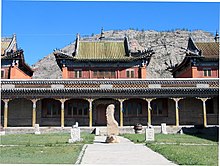
The fall of communism in 1991 restored the legality of public religious practice, and Tibetan Buddhism, which had been the predominant religion in the region before the rise of Communism, again rose to become the most widely practiced religion in Mongolia. The end of religious repression in the 1990s also allowed for other religions, such as Islam and Christianity, to spread in the country. According to the Barnabas Fund, the number of Christians grew from just 4 in 1989 to around 40,000 as of 2008.
See also: Buddhism in Mongolia, Islam in Mongolia
Education
During the state socialist period, education was one of the areas of significant achievement in Mongolia. Illiteracy was virtually eliminated, in part through the use of seasonal boarding schools for children of nomadic families. Funding to these boarding schools was cut in the 1990s, contributing to slightly increased illiteracy.
Primary and secondary education formerly lasted ten years, but has been expanded to eleven years recently and is set to be expanded further to twelve years.
Mongolian national universities are all spin-offs from the National University of Mongolia and the Mongolian University of Science and Technology .
The broad liberalization of the 1990s led to a boom in private institutions of higher education, although many of these establishments have difficulty living up to their name of "college" or "university".
Health
Health care in Mongolia is rapidly improving, leading to a higher life expectancy and a drop in infant and child mortality.
Average childbirth (fertility rate) is around 2.25 - 1.87 per woman (2007) and average life expectancy is 67-68 years. Infant mortality is at 1.9%-4% and child mortality is at 4.3%.
The health sector comprises 17 specialized hospitals and centers, 4 regional diagnostic and treatment centers, 9 district and 21 aimag general hospitals, 323 soum hospitals, 18 feldsher posts, 233 family group practices, and 536 private hospitals and 57 drug supply companies/pharmacies. In 2002 the total number of health workers was 33273, of which 6823 were doctors, 788 pharmacists, 7802-nurses and 14091 mid-level personnel. At present, there are 27.7 physicians and 75.7 hospital beds per 10,000 inhabitants.
Culture
Main article: Culture of Mongolia
The main festival is Naadam, which has been organised for centuries, consists of three Mongolian traditional sports, archery, horse-racing (over long stretches of open country, not the short racing around a track practiced in the West), and wrestling. Nowadays it is held on July 11 to July 13 in the honour of the anniversaries of the National Democratic Revolution and foundation of the Great Mongol State. Another very popular activity called Shagaa is the "flicking" of sheep ankle bones at a target several feet away, using a flicking motion of the finger to send the small bone flying at targets and trying to knock the target bones off the platform. This contest at Naadam is very popular and develops a serious audience among older Mongolians. In Mongolia, the khoomii, or throat singing, style of music is popular, particularly in parts of Western Mongolia.
The ornate symbol in the leftmost bar of the national flag is a Buddhist icon called soyombo. It represents the sun, moon, stars, and heavens per standard cosmological symbology abstracted from that seen in traditional thangka paintings.
Sports and recreation
Mongolia's Naadam festival takes place over three days in the summer and includes horse racing, archery, and Mongolian wrestling. These three sports, traditionally recognized as the three primary masculine activities, are the most widely watched and practiced sports throughout the country.

Horse riding is especially central to Mongolian culture. The long-distance races that are showcased during Naadam festivals are one aspect of this, as is the popularity of trick riding. One example of trick riding is the legend that the Mongolian military hero Damdin Sükhbaatar scattered coins on the ground and then picked them up while riding a horse at full gallop.
Other sports such as table tennis, basketball, and soccer are increasingly getting popular. More Mongolian table tennis players are competing internationally.
Wrestling is the most popular of all Mongol sports. It is the highlight of the Three Manly Games of Naadam. Historians claim that Mongol-style wrestling originated some seven thousand years ago. Hundreds of wrestlers from different cities and aimags around the country take part in the national wrestling competition.
There are no weight categories or age limits. Each wrestler has his own attendant herald. The aim of the sport is to knock one's opponent off balance and throw him down, making him touch the ground with his elbow and knee.
The winners are honored with ancient titles: the winner of the fifth round gets the honorary title of nachin (falcon), of the seventh and eighth rounds zaan (elephant), and of the tenth and eleventh rounds arslan (lion). The wrestler who becomes the absolute champion is awarded the title of avarga (Titan). Every subsequent victory at the national Naadam-festival will add an epithet to the avarga title, like "Invincible Titan to be remembered by all".
Beginning in 2003, the Mongolian parliament adopted a new law on Naadam, making amendments to some of the wrestling titles. The titles of iarudi and Khartsaga (Hawk) were added to the existing above-mentioned rules.
The traditional wrestling costume includes an open-fronted jacket, tied around the waist with a string. This is said to have come into use after the champion of a wrestling competition many years ago was discovered to be a woman. The jacket was introduced to ensure that only men could compete.
Mongolia's traditional wrestlers have made the transition to Japanese sumo wrestling with great success. Asashōryū Akinori was the first Mongolian to be promoted to the top sumo rank of yokozuna in 2003 and was followed by his countryman Hakuhō Shō in 2007.
Football is also played in Mongolia. The Mongolia national football team began playing again in the 1990s; it has yet to qualify for a major tournament. The Mongolia Premier League is the top domestic competition.
Several Mongolian women have excelled in pistol shooting: Munkhbayar Dorjsuren is a double world champion and Olympic bronze medal winner (now representing Germany), while Otryad Gundegmaa and Tsogbadrakh Munkhzul are, as of May 2007 ranked second and third in the world in the 25 m Pistol event.
Architecture
The traditional Mongolian dwelling is known as a yurt (Mongolian: ger). According to Mongolian artist and art critic N. Chultem, yurts and tents were the basis for development of the traditional Mongolian architecture. In the 16th ad 17th centuries, lamaseries were built throughout the country. Many of them started as yurt-temples. When they needed to be enlarged to accommodate the growing number of worshippers, the Mongolian architects used structures with 6 and 12 angles with pyramidal roofs to approximate to the round shape of a yurt. Further enlargement led to a quadratic shape of the temples. The roofs were made in the shape of marquees. The trellis walls, roof poles and layers of felt were replaced by stone, brick, beams and planks, and became permanent.
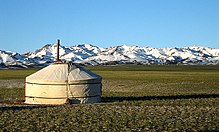
Chultem distinguished three styles in traditional Mongolian architecture: Mongolian, Tibetan and Chinese as well as combinations of the three. Among the first quadratic temples was Batu-Tsagaan (1654) designed by Zanabazar. An example of the yurt-style architecture is the lamasery Dashi-Choiling in Ulan Bator. The temple Lavrin (XVIII century) in the Erdene Zuu lamasery was built in the Tibetan tradition. An example of a temple built in the Chinese tradition is the lamasery Choijing Lamiin Sume (1904), which is a museum today. The quadratic temple Tsogchin in lamasery Gandan in Ulan Bator is a combination of the Mongolian and Chinese tradition. The temple of Maitreya (disassembled in 1938) is an example of the Tibeto-Mongolian architecture. Dashi-Choiling monastery has commenced a project to restore the temple and the 80-feet sculpture of Maitreya.
Music
Main article: Music of MongoliaThe music of Mongolia is strongly influenced by Tibetan Buddhism and nomadism. The natives dance the "tsam" to keep away evil spirits and it was seen the reminiscences of shamaning. The traditional music includes a variety of instruments and songs, including the song "koomi": delicately trained male voices, from the most serious tone to the highest, which are combined in full harmony.
Popular music
The first rock band of Mongolia was Soyol-Erdene, founded in the 1960s. Their Beatles-like manner was severely criticised by the Communist censorship. It was followed by Mungunhurhree, Ineemseglel, Urgoo, etc., carving out the path for the genre in the harsh environment of Communist ideology. Mungunhurhree and Haranga were to become the pioneers in the Mongolia's heavy rock music. Haranga approached its zenith in the late 1980s and 1990s.
The leader of Haranga, famous guitarist Enh-Manlai, generously helped the growth of their following generations of rockers. Among the followers of Haranga was the band Hurd. In the early 1990s group Har-Chono put the beginning for Mongolia's folk-rock merging the elements of the Mongolian tenuto song (poorly described as "long" song) into the genre.
By that time, the environment for development of artistic thought had become largely liberal thanks to the new democratic society in the country. The 1990s saw development of rap, techno, hip-hop and also boy bands and girl bands flourish at the turn of the millennium.
See also
- Architecture of Mongolia
- Communications in Mongolia
- Culture of Mongolia
- Foreign relations of Mongolia
- Goyol Fashion Festival
- Greater Mongolia region
- Military of Mongolia
- Mongolyn Skautyn Kholboo (Mongolian Scouts Association)
- Public holidays in Mongolia
- Transportation in Mongolia
References
- "Mongol" is often used almost synonymously, but is usually not understood to include minorities like Kazakhs or Tuvans.
- Mongolian National Statistical Office Bulletin December 2006
- Mongolian National Statistical Office Yearbook 2002
- ""Mongolia Standard Time is GMT (UTC) +8, some areas of Mongolia use GMT (UTC) + 7"". Time Temperature.com. Retrieved 2007-09-30.
{{cite web}}: Check date values in:|date=(help); Cite has empty unknown parameter:|coauthors=(help) - ""The Mongolian government has chosen not to move to Summer Time"". World Time Zone.com. Retrieved 2007-09-30.
{{cite web}}: Check date values in:|date=(help); Cite has empty unknown parameter:|coauthors=(help) - http://www.hostkingdom.net/earthrul.html
- the Mongol Messenger: Mongolia’s 25th Prime Minister, Sanjiin Bayar promises he will tackle high priority issues
- UBPost: Government Ministers approved
- "President George W. Bush Visits Mongolia". US embassy in Mongolia, 2005.
- Ulanbator
- CIA World Factbook countries by area
- "Republic of Mongolia" (PDF). 2004. Retrieved 2008-02-10.
- ^ CIA World Factbook: Mongolia
- Statistical Yearbook of Mongolia 2006, National Statistical Office, Ulaanbaatar, 2007
- Jeffs, Luke (2007-02-12). "Mongolia earns a sporting chance with fledgling operation". Dow Jones Financial News Online. Retrieved 2007-09-11.
- Cheng, Patricia (2006-09-19). "Mongolian bourse seeks foreign investment". International Herald-Tribune. Retrieved 2007-09-11.
- ^ U.S. Census Bureau International Data Base
- ^ World Population Prospects The 2006 Revision Highlights
- National Statistical Office: Statistical Yearbook 2002, p. 39. "Villages" in this case refers to settlements that are not part of a sum, see p. 37
- National Statistical Office: Statistical Yearbook 2002, pp. 43, 151
- Han, Jae-hyuck (2006-05-05). "Today in Mongolia: Everyone can speak a few words of Korean". Office of the President, Republic of Korea. Retrieved 2007-08-17.
{{cite news}}: Check date values in:|date=(help) - CIA Factbook - Mongolia
- International Religious Freedom Report 2007 - Mongolia
- Bureau of East Asian and Pacific Affairs - Mongolia
- National Ministry of Health Yearbook 2006
- UNICEF - At a glance: Mongolia
- UBPost: Child Mortality Rate Has Decreased, UNICEF Says
- "World ranking: 25m Pistol Women". International Shooting Sport Federation. 2007-05-29. Retrieved 2007-06-04.
{{cite web}}: Check date values in:|date=(help) - ^ Искусство Монголии. Moscow. 1984.
{{cite book}}: CS1 maint: location missing publisher (link) - "Cultural Heritage of Mongolia". Indiana University. Retrieved 2007-07-07.
Further reading
- Mongolia, Encyclopaedia Britannica
- "Mongolia". The World Factbook (2025 ed.). Central Intelligence Agency.
- Background notes on Mongolia, US Department of State

This image is available from the United States Library of Congress Prints and Photographs Division under the digital ID {{{id}}}
This tag does not indicate the copyright status of the attached work. A normal copyright tag is still required. See Misplaced Pages:Copyrights for more information.
External links
- The President of Mongolia Template:Mn icon
- Official Tourism Website of Mongolia
 Wikimedia Atlas of Mongolia
Wikimedia Atlas of Mongolia- Template:Dmoz
- Template:Wikitravel
- Mongolia, an external wiki
- Mongolia on International Business, an external wiki
Template:Countries of Central Asia Template:Countries and territories of East Asia
| Countries and dependencies of Asia | |||||||
|---|---|---|---|---|---|---|---|
| Sovereign states |
| ||||||
| States with limited recognition | |||||||
| Dependent territories |
| ||||||
| Special administrative regions of China | |||||||
| |||||||